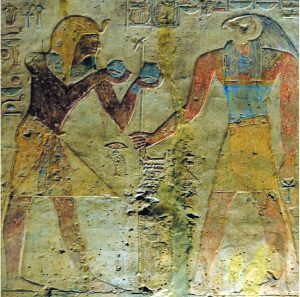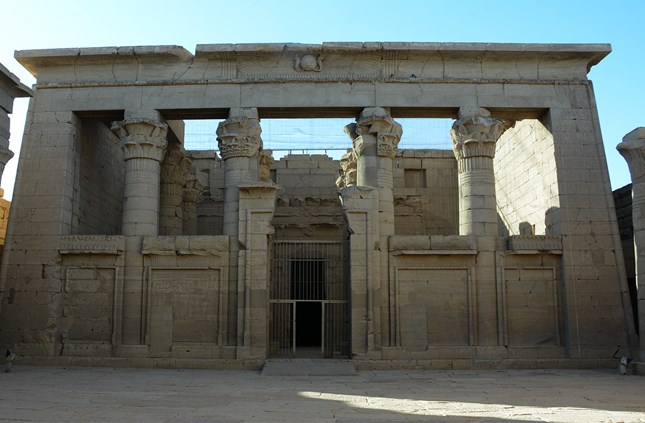The Temple of Kalabsha
Built during the reign of Augustus (30 BC – 14 AD), the first Roman emperor, this temple was dedicated to the Nubian sun god, Mandulis. The temple was built on the ruins of an older temple from the reign of King Amenhotep II of the Middle Kingdom (around 1400 BC). It is 76 meters long and 22 meters wide.
Description of the Temple
The temple consists of:
A quay overlooking the Nile River, where boats carrying worshippers and ritual statues would dock.
A 30-meter ascending path connecting the quay to the temple facade.
At the end of the ascending path, there are steps leading to the large stone terrace on which the temple was built.
Components of the Temple
A large pylon leading to an open courtyard, then a hypostyle hall, followed by two chambers behind it. At the end of the temple, we find the sanctuary.
There are also two chambers: one for the Nubian god Dedun and a northern chamber believed to have been built during the Ptolemaic period.
Specifications of the Temple
Firstly, the Pylon (the facade of the temple)

An image on one of the temple’s stone screens depicts the gods Thoth and Horus performing the royal purification ritual.
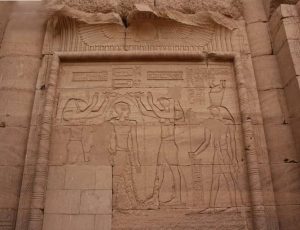
The Open Courtyard
Then we enter from it into the open courtyard, which is about 20 meters deep. It consists of 14 columns with capitals in the form of composite plant decorations, indicating the Greco-Roman influence on Egyptian architecture. There are no inscriptions on the walls of this courtyard. On both sides of the courtyard, there are four small rooms, each beginning with four columns connected by stone screens.
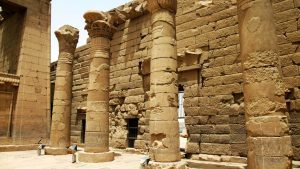 The Open Courtyard in the Temple of Kalabsha
The Open Courtyard in the Temple of Kalabsha
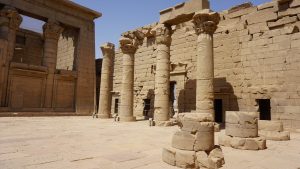
The Open Courtyard in the Temple of Kalabsha
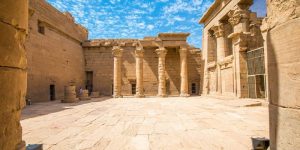
The Hypostyle Hall
Inside, it contains eight columns with many inscriptions, most notably the longest inscription in the Meroitic language (the language of Nubia). There are also inscriptions in Greek and Coptic. This inscription, dating back to 420 AD, describes the victory of the Nubian king (Silko) over his enemies, whom he described as idolaters. This indicates that he had become a Christian, and this is the first text that shows us the entry of the Nubians into Christianity in the fifth century. There are many wonderful scenes, most notably the god Mandulis in the form of a bird with a human head standing in a papyrus forest. There is also another small scene of King Amenhotep II (1400 BC) offering sacrifices to the gods.
The Most Beautiful Sight in the Hypostyle Hall: The God Mandulis in the Form of a Bird with a Human Head
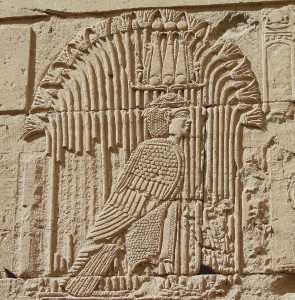
An image depicting the inscriptions in various languages at the Temple of Kalabsha (Meroitic, Coptic, and Greek)
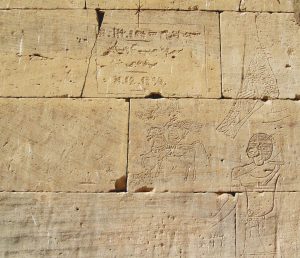
The Holy of holies
We enter the sanctuary of the temple and see scenes of kings worshiping the god Mandulis, the sun god of the Nubians. We also see scenes of the god Mandulis, as well as scenes of the god Horus inside the sanctuary. A solar alignment occurs inside the sanctuary on October 29th, which is the feast day of the god Mandulis, and February 14th, which is the feast day of the god Horus every year. We notice that the texts written in the temple were written in three languages: Greek, hieroglyphics, and the language of the Nubians called Meroitic. The sanctuary was used in the Christian era as a church, and there are many crosses carved on the walls of the temple. Between 1962 and 1963, during the construction of the High Dam, the temple was moved from its original location on the old Kalabsha Island to the new Kalabsha Island.
Image of the Interior of the Sanctuary: The King Worshipping the Nubian God Mandulis and the Goddess Hathor
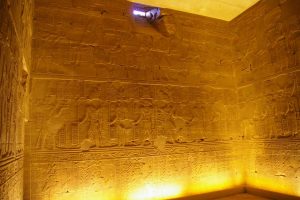
The Roman Emperor Augustus, on the right with the white crown, offers sacrifices to the god Mandulis. Then, on the left with the red crown, he offers to the goddess Hathor.
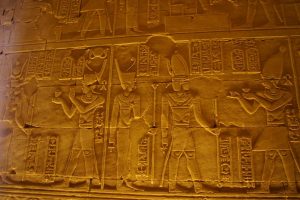
The Shrine of the God Dedun
This magnificent shrine was partially carved into the rock, with walls and columns surrounding three sides of the front courtyard built of sandstone. On each side of the entrance to the sanctuary, there is a scene of the king worshiping the god Dedwen, one of the most important Nubian gods. There are also two other scenes on the lintel, and these are the only inscriptions in the shrine. The shrine is also considered the mammisi of Kalabsha (means the birth house in the Coptic language).

The Temple of Qertassi
The temple is considered the most beautiful building in the area. It consists of four columns with composite plant capitals and two Hathoric columns at its entrance. The original decorations of the temple exist on only one of its columns. Although no royal names are mentioned in it, the architectural similarity with the kiosk of Trajan on Philae Island indicates that it was also built in the Roman era. The temple was originally located on Qertassi Island, about 50 km south of Aswan, but it was moved by UNESCO to the new Kalabsha Island in 1960 AD.
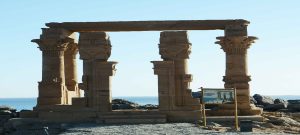
The Temple of Gerf Hussein
Originally located about 90 km south of Aswan, the great king Ramses II (around 1279-1213 BC) built it. The temple was 60 meters long, and the part cut into the rock was 43 meters deep. In front of the temple was a processional way lined on both sides by statues of sphinxes with ram’s heads. This temple is similar to the Great Temple of Abu Simbel, as the sanctuary in the Temple of Gerf Hussein contains four statues carved into the rock of four deities: Ramses II (in his sacred form as a god), Ptah-Tatenen, Hathor, and Ptah as the god of the temple. Unfortunately, only certain parts of this temple were saved by UNESCO. Храм Герфа Хусейна
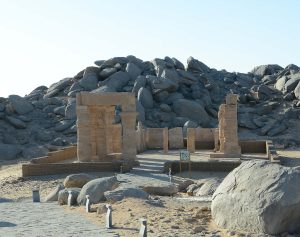
The Temple of Beit el-Wali
Originally located 42 km south of the High Dam, it was moved in 1965 to the new Kalabsha Island by UNESCO. The great king Ramses II built it and dedicated it to the god Amun-Ra Other deities such as Isis, Horus, Hathor, and the goddess Selket in the form of a scorpion were also worshipped in it. The triad of Elephantine, consisting of Khnum (the ram), his wife Satet, and their daughter Anuket, was also worshipped.
Description of the Temple
The temple is preceded by a mud-brick pylon leading to an entrance that leads (as in the Temple of Gerf Hussein) to the rest of the temple’s parts carved into the rock, which are a wide hall with two columns and a sanctuary. The most important feature of this temple is its preservation of its colored decorations, where we can see a scene of Ramses II offering sacrifices in front of both Horus and Isis (on the left side). The king also offers sacrifices in front of Khnum and his daughter Anuket on the right side.
The king Ramses II offers sacrifices to the god Horus.
